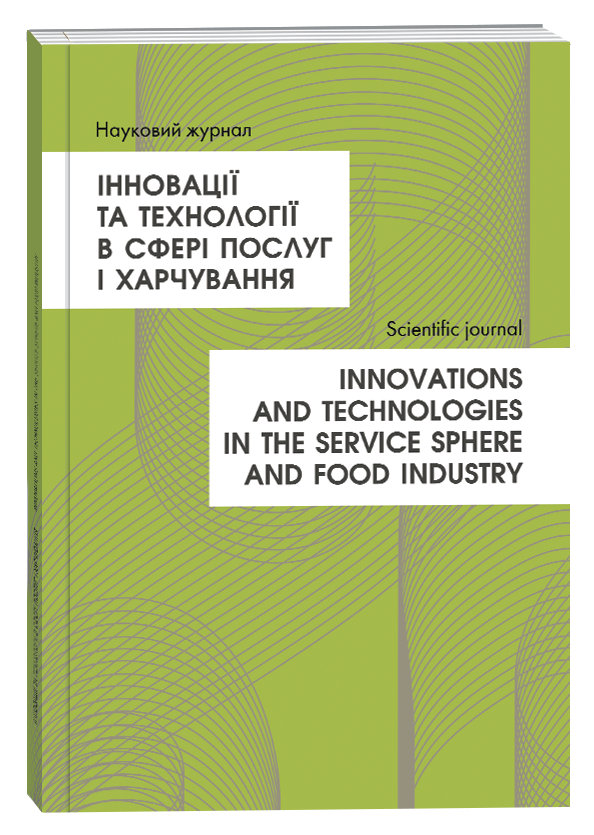DEVELOPMENT OF CHICKEN LIVER PÂTÉ WITH BUCKWHEAT AND OATMEAL
Abstract
The main strategies for the development of meat products include enriching them with nutrients, reducing fat and caloric content and lowering production costs. These objectives can be achieved by partially replacing meat with plant-based ingredients, provided that the quality of the final product is not compromised. The aim of this study was to develop a combined pâté using chicken liver, vegetables, oatmeal and buckwheat, and to determine its physicochemical and sensory properties, nutritional value and caloric content. The pâté samples were prepared using the recommended heat treatment methods for the ingredients. Standard techniques were used to determine the physicochemical properties of the pâté, while an expert sensory evaluation method was used to analyse the taste, smell, colour and consistency of the pâté. Using the expert method, the weighting coefficients of the sensory properties of the combined pate compositions and the complex quality index were also determined. The nutritional value and caloric content of the pâté samples were calculated. The developed pâté containing 10% oatmeal and 10% cooked buckwheat was recommended for production as it received the highest sensory ratings from the panel of experts. The developed combined pâté has a delicate, slightly sweet taste of liver and a pleasant liver aroma with a hint of roasted vegetables. The consistency of the pâté is dense and uniform, and its colour is light brown with bright orange flecks, caused by the addition of carrots to the recipe. Experts believe that taste is the most crucial sensory characteristic of pâtés. The developed pâté contains 53.4% moisture, 1.33% total ash 11.6% protein, 6.5% fat, and 6.5% carbohydrates. The caloric content of the pâté is 130.9 kcal. The density of the pâté is 1063.8 kg/m3 and its water-binding capacity, expressed as a percentage of the pâté, is 42.9%. Combined pâté, made from chicken liver, vegetables, oatmeal, and buckwheat, is enriched with nutrients from plant-based ingredients. Its cost is also lower than that of traditional pâté, due to the partial replacement of meat ingredients with vegetable ones.
References
Alemayehu G. F., Forsido S. F., Tola Y. B., & Amare E. (2023). Nutritional and phytochemical composition and associated health benefits of oat (Avena sativa) grains and oat-based fermented food products. The Scientific World Journal, vol. 2023. DOI: https://doi.org/10.1155/2023/2730175
Anisimova E. Y., Knyazhechenko O. A., Slozhenkina M. I., Natyrov A. K., Danilov Y. D., & Miroshnik A. S. (2023). Innovative meat product technology: a new look at traditional nutrition. In: VIII International Conference on Advanced Agritechnologies, Environmental Engineering and Sustainable Development (AGRITECH-VIII 2023), vol. 390. DOI: https://doi.org/10.1051/e3sconf/202339002045
Assenova B., Okuskhanova E., Rebezov M., Zinina O., Baryshnikova N., Vaiscrobova E., Kasatkina E., Shariati M.A., Khan M.U., & Ntsefong G.N. (2020). Effect of germinated wheat (Triticum aestivum) on chemical, amino acid and organoleptic properties of meat pate. Potravinarstvo Slovak Journal of Food Sciences, no. 14, pp. 580–586. DOI: https://doi.org/10.5219/1273
Atambayeva Z., Nurgazezova A., Rebezov M., Kazhibayeva G., Kassymov S., Sviderskaya D., Toleubekova S., Assirzhanova Z., Ashakayeva R., & Apsalikova Z. (2022). A risk and hazard analysis model for the production process of a new meat product blended with germinated green buckwheat and food safety awareness. Frontiers in Nutrition, no. 9. DOI: https://doi.org/10.3389/fnut.2022.902760
Augustyńska-Prejsnar A., Ormian M., Sokołowicz Z., & Kačániová M. (2022). The effect of the addition of hemp seeds, amaranth, and golden flaxseed on the nutritional value, physical, sensory characteristics, and safety of poultry pâté. Applied Sciences, no. 12(10). DOI: https://doi.org/10.3390/app12105289
Badar I.H., Liu H., Chen Q., Xia X., & Kong B. (2021). Future trends of processed meat products concerning perceived healthiness: A review. Comprehensive Reviews in Food Science and Food Safety, no. 20(5), pp. 4739–4778. DOI: https://doi.org/10.1111/1541-4337.12813
Borsolyuk L., & Verbytskyi S. (2023). The role of plant components in imparting functional properties to restructured meat products. Food Resources, no. 11(20), pp. 7–17. DOI: https://doi.org/10.31073/foodresources2023-20-01
Bozhko N., Tischenko V., Pasichnyi V., & Matsuk Y. (2020). Analysis of the possibility of fish and meat raw materials combination in products. Potravinarstvo Slovak Journal of Food Sciences, no. 14, pp. 647–655. DOI: https://doi.org/10.5219/1372
Calderón-Oliver M., & López-Hernández L. H. (2022). Food vegetable and fruit waste used in meat products. Food Reviews International, no. 38(4), pp. 628–654. DOI: https://doi.org/10.1080/87559129.2020.1740732
Capuano E., Oliviero T., Fogliano V., & Pellegrini N. (2018). Role of the food matrix and digestion on calculation of the actual energy content of food. Nutrition Reviews, no. 76(4), pp. 274–289. DOI: https://doi.org/10.1093/nutrit/nux072
Cerón-Guevara M. I., Santos E. M., Lorenzo J. M., Pateiro M., Bermúdez-Piedra R., Rodríguez J. A., Castro-Rosas J., & Rangel-Vargas E. (2021). Partial replacement of fat and salt in liver pâté by addition of Agaricus bisporus and Pleurotus ostreatus flour. International Journal of Food Science and Technology, no. 56(12), pp. 6171–6181. DOI: https://doi.org/10.1111/ijfs.15076
Chernukha I., Kupaeva N., Khvostov D., Bogdanova Y., Smirnova J., & Kotenkova E. (2023). Assessment of antioxidant stability of meat pâté with allium cepa husk extract. Antioxidants, no. 12(5). DOI: https://doi.org/10.3390/antiox12051103
Davidescu M.A., Panzaru C., Ciobanu A., Madescu B.M., Bolohan I., Porosnicu I., & Usturoi A. (2024). Analysis of quality of turkey pâté: organoleptic, physicochemical and microbiological evaluation. Scientific Papers Animal Science and Biotechnologies, no. 57(2), pp. 170–175.
Decker E.A., Rose D.J., & Stewart D. (2014). Processing of oats and the impact of processing operations on nutrition and health benefits. British Journal of Nutrition, no. 112(S2), pp. S58-S64. DOI: https://doi.org/10.1017/S000711451400227X
Frunză G., Radu-Rusu C.G., Albu A., & Pop I. M. (2022). Improving the quality of products in food industry. Application of quality function development methodology for chicken liver pâté. Scientific Papers. Series D. Animal Science, no. 65(2), pp. 322–329.
Gebhardt S. E., & Thomas R. G. (2002). Nutritive value of foods. U.S. Department of Agriculture, Agricultural Research Service. Home and Garden Bulletin, no. 72. Beltsville, Maryland.
Glišić M., Bošković Cabrol M., Čobanović N., Starčević M., Samardžić S., Veličković I., & Maksimović Z. (2024). The effects of sunflower and maize crop residue extracts as a new ingredient on the quality properties of pork liver pâtés. Foods, no. 13(5), article number 788. DOI: https://doi.org/10.3390/foods13050788
Hamzeh A., Azizieh A., & Yazagy S. (2016). The effect of the fat percentage and liver type in the stability and pH value of locally prepared liver pate. International Food Research Journal, no. 23(3), pp. 1131–1135.
Huda Md.N., Lu S., Jahan T., Ding M., Jha R., Zhang K., Zhang W., Georgiev M.I., Park S.U., & Zhou M. (2021). Treasure from garden: Bioactive compounds of buckwheat. Food Chemistry, no. 335. DOI: https://doi.org/10.1016/j.foodchem.2020.127653
Jalal H., Salahuddin M., Sofi A. H., Wani S.A., Pal M. A., & Hussain A. (2021). Effect of oatmeal as fat replacer on the quality of low fat Goshtaba prepared by traditional and machine methods. Journal of Meat Science, no. 16, pp. 7–11. DOI: https://doi.org/10.5958/2581-6616.2021.00003.7
Leszczyńska D., Wirkijowska A., Gasiński A., Średnicka-Tober D., Trafiałek J., & Kazimierczak R. (2023). Oat and oat processed products – technology, composition, nutritional value, and health. Applied Sciences, no. 13(20), article number 11267. DOI: https://doi.org/10.3390/app132011267
Lucas-González R., Pérez-Álvarez J.Á., Viuda-Martos M., & Fernández-López J. (2021). Pork liver pâté enriched with persimmon coproducts: Effect of in vitro gastrointestinal digestion on its fatty acid and polyphenol profile stability. Nutrients, no. 13(4). DOI: https://doi.org/10.3390/nu13041332
Marudova M., Momchilova M., Antova G., Petkova Z., Yordanov D., & Zsivanovits G. (2017). Investigation of fatty acid thermal transitions and stability in poultry pates enriched with vegetable components. Journal of Thermal Analysis and Calorimetry, no. 133, pp. 539-547. DOI: https://doi.org/10.1007/s10973-017-6841-z
Matiucci M. A., Chambo A. P. S., Mikcha J. M. G., da Silva Réia S. M., Vitorino K. C., de Moura L. B., Feihrmann A. C., & de Souza M. L. R. (2021). Elaboration of pâté using fish residues. Acta Veterinaria Brasilica, no. 15(3), pp. 209–219. DOI: https://doi.org/10.21708/avb.2021.15.3.9421
Németh R., Turóczi F., Csernus D., Solymos F., Jaksics E., & Tömösközi S. (2021). Characterization of chemical composition and techno‐functional properties of oat cultivars. Cereal Chemistry, no. 98(6), pp. 1183–1192. DOI: https://doi.org/10.1002/cche.10470
Noopur K., Chauhan J. K., Kumar L., Chandegara A. K., & Panwar S. S. (2023). Vegetables for food and nutritional security: A review. Indian Research Journal of Extension Education, no. 23(4), pp. 21–27. DOI: https://doi.org/10.54986/irjee/2023/oct_dec/21-27
Paudel D., Dhungana B., Caffe M., & Krishnan P. (2021). A review of health-beneficial properties of oats. Foods, no. 10(11). DOI: https://doi.org/10.3390/foods10112591
Rezler R., Krzywdzińska-Bartkowiak M., & Piątek M. (2021). The influence of the substitution of fat with modified starch on the quality of pork liver pâtés. LWT, no. 135. DOI: https://doi.org/10.1016/j.lwt.2020.110264
Porto-Fett A. C. S., Shoyer B. A., Shane L. E., Osoria M., Henry E., Jung Y., & Luchansky J. B. (2019). Thermal inactivation of Salmonella in pâté made from chicken liver. Journal of Food Protection, no. 82(6), pp. 980–987. DOI: https://doi.org/10.4315/0362-028x.jfp-18-423
Šiška L., Gál R., Štefunko F., Polášek Z., Lazárková Z., Pětová M., Trvdoň Z., & Salek R. N. (2024). Quality evaluation of chicken liver pâté affected by algal hydrocolloids addition: A textural and rheological approach. Animals, no. 14(18). DOI: https://doi.org/10.3390/ani14182715
Skwarek P., & Karwowska M. (2023). Fruit and vegetable processing by-products as functional meat product ingredients – A chance to improve the nutritional value. LWT, no. 189. DOI: https://doi.org/10.1016/j.lwt.2023.115442
Socaciu M. I., Semeniuc C. A., Tanislav A. E., Mureşan E. A., Pușcaș A., Truță A. M., & Mureşan V. (2023). Formulation development and characterization of plant-based alternatives to pâté using forest ingredients. Journal of Food Science and Technology, no. 60, pp. 3082–3093. DOI: https://doi.org/10.1007/s13197-023-05852-7
Sofi S. A., Ahmed N., Farooq A., Rafiq S., Zargar S. M., Kamran F., Dar T. A., Mir S. A., Dar B. N., & Mousavi Khaneghah A. (2023). Nutritional and bioactive characteristics of buckwheat, and its potential for developing gluten-free products: An updated overview. Food Science & Nutrition, no. 11, pp. 2256–2276. DOI: https://doi.org/10.1002/fsn3.3166
Stachniuk A., Trzpil A., Montowska M., & Fornal E. (2023). Heat-stable peptide markers specific to rabbit and chicken liver tissue for meat product authentication testing. Food Chemistry, no. 424. DOI: https://doi.org/10.1016/j.foodchem.2023.136432
Tang Y., Li S., Yan J., Peng Y., Weng W., Yao X., Gao A., Cheng J., Ruan J., & Xu B. (2022). Bioactive components and health functions of oat. Food Reviews International, no. 39(7), pp. 4545–4564. DOI: https://doi.org/10.1080/87559129.2022.2029477
Yang H.-S., Kim G.-D., Choi S.-G., & Joo S.-T. (2010). Physical and sensory properties of low fat sausage amended with hydrated oatmeal and various meats. Korean Journal for Food Science of Animal Resources, no. 30(3), pp. 365–372. DOI: https://doi.org/10.5851/kosfa.2010.30.3.365
Yang Z., Xie C., Bao Y., Liu F., Wang H., & Wang Y. (2023). Oat: Current state and challenges in plant-based food applications. Trends in Food Science & Technology, no. 134, pp. 56–71. DOI: https://doi.org/10.1016/j.tifs.2023.02.017
Yessengaziyeva A., Uzakov Y., Chernukha I., Kaimbayeva L., Kalashinova L., & Zhantleuov D. (2023). The use of buckwheat flour in the technology of semi-smoked sausage. Potravinarstvo Slovak Journal of Food Sciences, no. 17(1), pp. 311–323. DOI: https://doi.org/10.5219/1861
Zamaratskaia G., Gerhardt K., Knicky M., & Wendin K. (2024). Buckwheat: An underutilized crop with attractive sensory qualities and health benefits. Critical Reviews in Food Science and Nutrition, no. 64(33), pp. 12303–12318. DOI: https://doi.org/10.1080/10408398.2023.2249112
Zenkova M. (2021). Bioactivated buckwheat in terms of its nutritional value. Food Science & Technology, no. 15, pp. 4–10. DOI: https://doi.org/10.15673/fst.v15i2.2030



